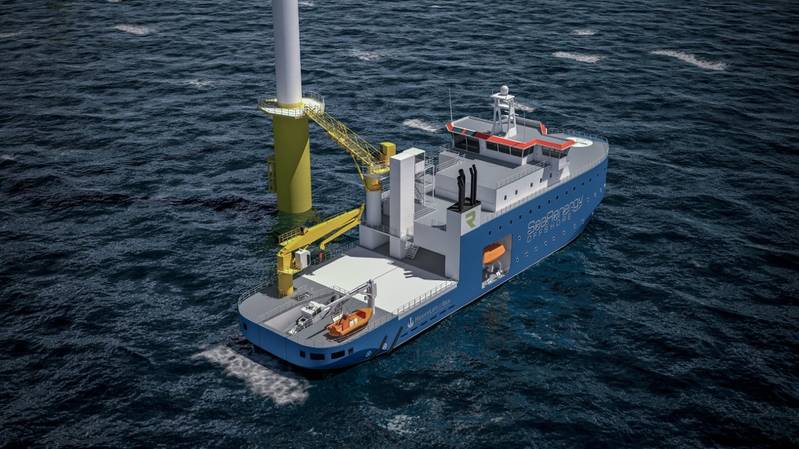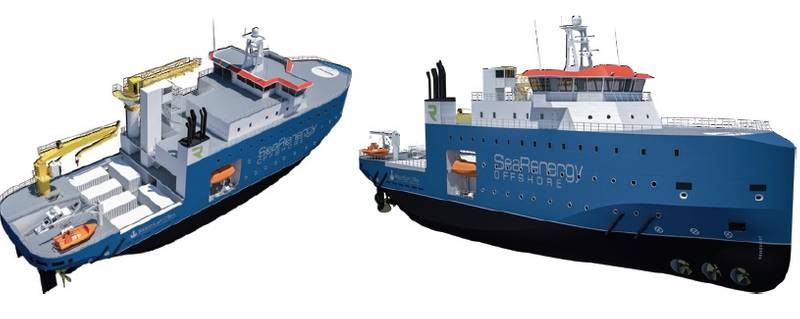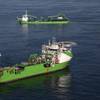HEAVYLIFT@SEA and SeaRenergy Offshore present the new offshore assistance vessel (OAV) SR1 concept
Dedicated ship design office HEAVYLIFT@SEA has partnered with service provider to the offshore industry SeaRenergy to produce a new vessel design that is poised to benefit from best practice from both worlds: ship design and offshore experience.
According to the designers, the new 72-meter vessel targets both efficiency and comfort, developed with a focus on minimizing losses during operation but still with a cost efficient propulsion arrangement (ERN 99,99,99,95) with low fuel consumption and maintenance cost. The vessel is designed to reduce motion and increase comfort for technicians in order to mitigate risk of sea sickness and weather downtime, especially in the harsh conditions of the North Sea. It accommodates up to 60 persons in single cabins, embedded in a true passenger ship class vessel including two day rooms, auditorium and a fitness room.
Maximized utilization of vessel and technicians was also a focus for the designers as the new vessel concept strives to achieve efficiency in O&M and is therefore designed to be able to stay on location for several weeks, offering more working time and less time in transit.
The configuration enables an efficient flow of people and spare parts around the vessel. The motion compensated gangway, which is accessible directly from the elevator grants direct access to wind turbines and offshore platforms in significant wave heights of up to 2.5 meters, arranged for workability at water levels of +/- 4.0 m around MSL. With the cargo transfer system, a barrier-free handling of spare parts and components of is possible up to 300 kg without using a crane.
The vessel is equipped with a daughter craft in its own hangar at the stern to be utilized as a second means for access to the boat landing of offshore structures. The hangar increases the safety of operation, especially in rough weather conditions.
According to the vessel’s developers, the new vessel class also holds an attractive outlook also for investors. Analysts estimate that the SOV market has a potential of 25 - 40 SOVs until 2020 whereas Offshore Wind is expected to grow to 23.5 GW, tripling current installed capacity by 2020.
“Our new design already reflects the new requirements regarding seakeeping behavior and comfort for technicians combined with cost reductions will lead to increasing demand in SOVs,” said Hendrik Groene, Managing Director of Heavylift@Sea. “We see already, that this new vessel class replaces older units coming from the oil and gas segment.”
“The O&M market is only starting, and therefore demand for SOVs will grow with commissioned wind farms,” said Dr. Benjamin Vordemfelde, Managing Director of SeaRenergy. “SOVs are an attractive market segment with an excellent perspective offering stable growth and attractive charters. Therefore we see the market entry into the SOV segment as the logical next step to develop our company further and also meet the growing demand for this new vessel class.”
About the vessel
• Vessel length: 72 m, consideration of wave lengths in the North Sea
• Passenger ship class (requirement of MLC 2006 is full filled)
• Less failure probability of the components
• Cost efficient arrangement
• Lowest possible maintenance costs
• DP (requirement of ERN 99,99,99,95 is full filled)
• Gangway, arranged for workability at Hs = 2.5 m and water levels of +/- 4.0 m around MSL
• Direct access from elevator to gangway
• Handling of larger components (ca. 300 kg), independent from the crane
• Equipped with a cargo hold for the dry and save storage
• The hatch covers can be operated with the vessels own crane autonomy
• All containers can be placed at their designated stowage position
• All containers can be loaded and unloaded independently by crane
• Direct access from the cargo hold to the working zone
• Storage of the daughter craft in a hangar
• Safe boarding to the daughter craft
• Safe launching and recovering of the daughter craft also during the SOV is moving
• Flexible arrangement for different kinds of daughter crafts















